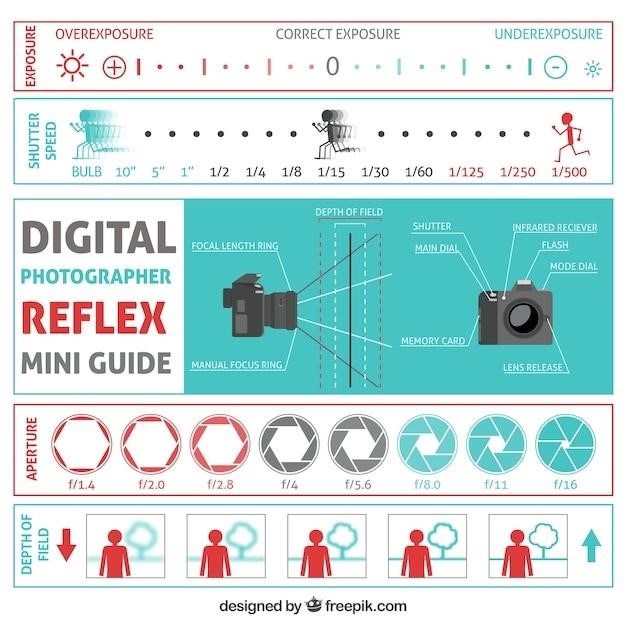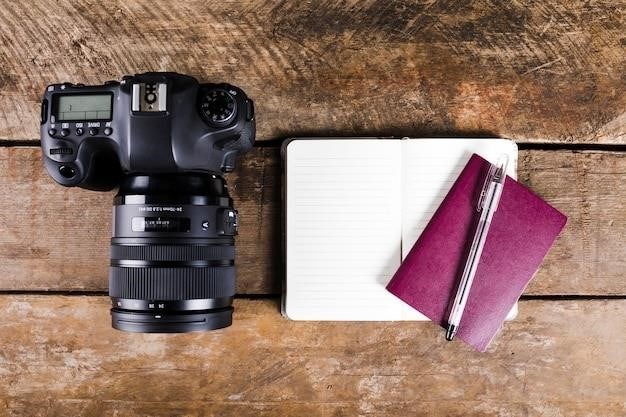nikon d500 manual english

Nikon D500 Manual⁚ A Comprehensive Guide
This comprehensive guide provides a detailed exploration of the Nikon D500 manual, covering everything from basic operation to advanced techniques․ We’ll delve into essential camera settings, key features, and how to navigate the camera’s menus and controls․ Whether you’re a beginner or an experienced photographer, this guide will help you master the D500 and unlock its full potential․
Introduction
The Nikon D500 is a powerful DSLR camera designed for both professional and enthusiast photographers․ Its advanced features, including a 20․9MP DX-format CMOS sensor, EXPEED 5 image processing engine, and 153-point autofocus system, make it a versatile tool for capturing stunning images in a variety of situations․ To fully harness the capabilities of this impressive camera, understanding its user manual is essential․
This manual serves as your comprehensive guide to navigating the intricacies of the Nikon D500․ It will provide you with the knowledge necessary to unlock the full potential of your camera, from basic operation and menu navigation to advanced techniques and settings․ Whether you’re a beginner looking to grasp the fundamentals of photography or an experienced photographer seeking to refine your skills, this manual will be your trusted companion․
Where to Find the Nikon D500 Manual
Accessing the Nikon D500 manual is a straightforward process, with multiple options available to suit your preferences․ Whether you prefer the convenience of online resources or the portability of a downloadable PDF, you can easily obtain the information you need to understand your camera․
The official Nikon website offers a dedicated Download Center where you can find various resources, including firmware updates, software, and manuals for a wide range of Nikon products․ The D500 manual is readily available within this center, allowing you to access it directly from your computer or mobile device․
Alternatively, you can opt for a downloadable PDF version of the manual․ This provides a convenient way to store and access the manual offline, making it ideal for travel or situations where internet connectivity is limited․
2․1․ Online Resources
The internet offers a wealth of resources for accessing the Nikon D500 manual, providing convenient and readily available options for users․ The official Nikon website serves as a central hub for all things Nikon, including comprehensive support documentation․
Beyond the official website, various third-party platforms also offer access to the D500 manual․ These platforms may provide additional features, such as search functionality or the ability to download the manual as a PDF․
2․2․ Downloading the PDF Manual
For those who prefer a physical copy or want to access the manual offline, downloading a PDF version is a convenient option․ The Nikon website provides a downloadable PDF version of the D500 manual, allowing you to save it to your computer or mobile device for easy reference․ This option is especially useful for users who frequently travel or prefer to keep their manuals readily accessible․
The PDF manual typically contains the same information as the online version, but it offers the added benefit of offline access․ You can easily search within the PDF document, bookmark specific pages, and even print the manual for physical use․ Some third-party websites also offer downloads of the D500 manual in PDF format, providing alternative sources for obtaining this valuable resource․
To download the PDF manual, simply visit the Nikon website, locate the D500 manual, and click on the “Download PDF” button․ The file will then be saved to your computer, allowing you to access it at any time․
Key Features of the Nikon D500
The Nikon D500 is a powerful DSLR camera designed for enthusiasts and professionals seeking high-quality images and performance․ Its key features include a 20․9MP DX-format CMOS sensor, which captures stunning detail and vibrant colors, even in low-light conditions․ The EXPEED 5 image processing engine delivers exceptional image quality with reduced noise and enhanced detail, making it ideal for various photographic genres․
Another standout feature is the D500’s impressive autofocus system, boasting 153 focus points, including 99 cross-type sensors․ This sophisticated system ensures precise and rapid focusing, even in challenging lighting conditions․ The camera also offers a remarkable burst rate of up to 10 frames per second, allowing you to capture fast-paced action with ease․ For photographers seeking versatility, the D500 boasts a tilting LCD screen, providing flexibility for shooting from various angles and perspectives․
Furthermore, the D500 incorporates 4K video recording capabilities at 30 frames per second, enabling you to capture high-resolution video with impressive detail and clarity․ Its built-in Wi-Fi and Bluetooth connectivity allow for seamless wireless image transfer and remote control of the camera, adding convenience to your workflow․ These features combine to make the D500 a highly capable and versatile DSLR camera for photographers of all skill levels․

Using the Nikon D500 Manual
The Nikon D500 manual is your comprehensive guide to understanding and utilizing all the features and functionalities of this powerful DSLR camera․ It’s essential to familiarize yourself with the contents of the manual to maximize your photographic experience․ The manual provides detailed explanations of each camera setting, control, and menu option, allowing you to fully grasp how to operate your D500 effectively․
Start by reading the “Introduction” and “Getting to Know the Camera” sections to gain a basic understanding of the D500’s layout, buttons, and essential features․ Once you have a grasp of the fundamentals, explore the “Camera Body” and “Control Panel” sections to learn about the various controls and their functions․ The manual also delves into “Exploring the Camera’s Menus,” providing detailed information on navigating the menu system and adjusting camera settings according to your needs․
For advanced photography, dedicate time to understanding “Essential Camera Settings,” including ISO sensitivity, aperture, shutter speed, and white balance․ The “Advanced Techniques” section covers specialized features like autofocus modes, white balance settings, and exposure compensation, allowing you to fine-tune your photography skills․ Remember to keep the manual handy as a reference tool while you explore the D500’s capabilities and experiment with different settings to discover your unique photographic style․
Understanding the Camera’s Controls
The Nikon D500 boasts a comprehensive array of controls designed to provide photographers with a high level of customization and control over their images․ The manual provides a detailed breakdown of each button, dial, and switch, explaining their functions and how to utilize them effectively․ Mastering these controls allows you to adjust camera settings, activate specific modes, and fine-tune your shots to achieve the desired results․
Familiarize yourself with the layout of the camera body, paying particular attention to the buttons and dials located on the top, back, and side of the camera․ Understand the purpose of the shutter button, the mode dial, the command dial, and the various function buttons․ The manual also provides detailed explanations of the control panel located on the back of the camera, which displays essential information like shutter speed, aperture, ISO sensitivity, and exposure compensation․
By carefully studying the manual and practicing with the camera’s controls, you’ll gain a deep understanding of how to manipulate the D500’s settings and capture stunning images․ Whether you’re shooting in automatic, semi-automatic, or manual mode, a thorough comprehension of the camera’s controls is essential for achieving your photographic goals․
5․1․ The Control Panel
The Nikon D500’s control panel, located on the back of the camera, serves as a central hub for displaying critical information and adjusting key settings․ It’s a compact yet comprehensive display that provides photographers with a clear overview of their camera’s status and allows for quick adjustments on the fly․ The control panel presents a variety of information, including shutter speed, aperture, ISO sensitivity, exposure compensation, focus mode, white balance, metering mode, and battery level․
The manual guides you through understanding each element displayed on the control panel, explaining its significance and how it relates to your image settings․ You’ll learn how to interpret the various icons and symbols used to represent different camera functions and settings․ This knowledge empowers you to monitor your camera’s settings, make informed adjustments, and ensure your images are captured precisely as intended․
The control panel serves as a vital communication tool between the camera and the photographer, providing instant feedback on the camera’s current settings and allowing for quick adjustments to ensure optimal image capture․ By mastering the information displayed on the control panel, you’ll gain confidence in your ability to capture stunning images with the Nikon D500․
5․2․ The Camera Body
The Nikon D500 manual provides a detailed exploration of the camera body, guiding you through its various components and functions․ You’ll learn about the physical layout of the camera, including the location of buttons, dials, and ports․ This knowledge allows you to navigate the camera body with ease, confidently accessing essential controls during your photography sessions․ The manual delves into the purpose and operation of each button, explaining how they interact with the camera’s settings and features․
You’ll discover how to use the mode dial to select different shooting modes, the shutter button to capture images, the zoom ring to adjust the focal length of your lens, and the focus ring to achieve sharp focus on your subject․ The manual also provides detailed instructions on using the flash, the viewfinder, and the LCD screen, explaining how to adjust settings, review images, and navigate the camera’s menus․ By thoroughly understanding the camera body and its various components, you’ll develop a deeper connection with your camera, allowing you to control its functions with precision and ease․
The Nikon D500 manual serves as your comprehensive guide to mastering the camera body, enabling you to harness its full potential and capture captivating images with confidence and precision․
Exploring the Camera’s Menus
The Nikon D500 manual offers a detailed exploration of the camera’s menus, providing a comprehensive guide to navigating its extensive array of settings and options․ The manual begins by outlining the structure of the menus, explaining how they are organized and how to access them․ You’ll learn how to navigate through different menu levels using the camera’s buttons and dials, efficiently finding the specific settings you need to adjust․ The manual then delves into each menu category, providing detailed descriptions of the available settings and their functions․
You’ll discover how to customize the camera’s shooting modes, adjust picture quality, control white balance, and fine-tune the autofocus system․ The manual also explains how to access the camera’s storage options, review captured images, and adjust the display settings․ By carefully studying the camera’s menus and understanding the options available, you’ll gain a deeper appreciation for the D500’s capabilities and how to tailor its settings to your specific photographic needs․ The manual serves as a valuable resource for unlocking the full potential of your camera, allowing you to achieve the desired results in any shooting situation․
The Nikon D500 manual empowers you to explore the camera’s menus with confidence, transforming your photographic journey into an enriching and creative experience․
Essential Camera Settings
The Nikon D500 manual provides a comprehensive guide to the essential camera settings that control the quality and style of your images․ It begins by outlining the core settings that influence exposure, including aperture, shutter speed, and ISO sensitivity․ You’ll learn how each setting interacts with the others to create the desired exposure and how to adjust them manually or automatically․ The manual then explores the camera’s picture quality settings, explaining the different image formats, file sizes, and compression options available․ You’ll discover how to choose the best settings for your specific needs, whether you’re shooting for print or for online sharing․
The manual also delves into the camera’s white balance settings, explaining how to adjust them to achieve accurate color reproduction under different lighting conditions․ You’ll learn about the various white balance presets and how to manually set the white balance using a custom reference point․ The manual further explores the camera’s autofocus settings, providing an in-depth explanation of the different autofocus modes, focus areas, and tracking options available․ You’ll discover how to choose the right autofocus settings for your shooting style and subject matter․ By understanding these essential camera settings and how to adjust them effectively, you’ll gain greater control over your images and unlock the full creative potential of the Nikon D500․
Advanced Techniques
The Nikon D500 manual dives deep into advanced photographic techniques that unlock the camera’s full potential․ It guides you through the intricacies of the D500’s autofocus system, explaining the different modes like single-point AF, dynamic-area AF, and 3D-tracking AF․ You’ll learn how to select the optimal autofocus mode for various shooting situations, ensuring sharp focus even with fast-moving subjects․ The manual also explores the camera’s white balance settings, providing detailed instructions on how to achieve accurate color reproduction under challenging lighting conditions․ You’ll discover the nuances of using custom white balance, preset white balance, and color temperature adjustments, enabling you to capture vibrant and true-to-life colors in your images․
Beyond autofocus and white balance, the manual covers advanced shooting techniques like bracketing, focusing, and exposure compensation․ You’ll learn how to use bracketing to capture a series of images with different exposures for greater flexibility in post-processing․ The manual also explains the different focusing techniques, including manual focusing, zone focusing, and focus stacking, empowering you to achieve precise focus for various subjects and scenarios․ Furthermore, it guides you through the intricacies of exposure compensation, enabling you to fine-tune the exposure for optimal image brightness and contrast․ By mastering these advanced techniques, you’ll elevate your photography skills and unlock the full creative potential of the Nikon D500․




